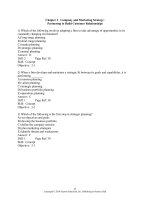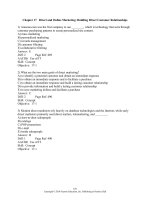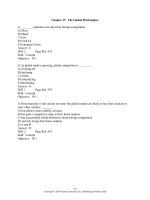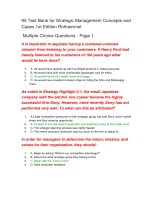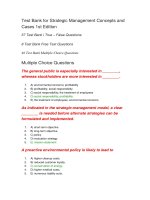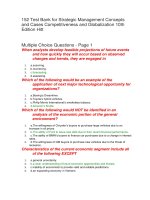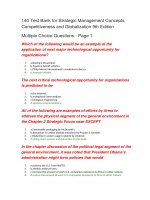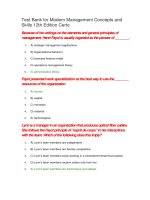kupdf com test bank chapter 2 cost concepts
Bạn đang xem bản rút gọn của tài liệu. Xem và tải ngay bản đầy đủ của tài liệu tại đây (207.89 KB, 36 trang )
Chapter 2
Cost Terms, Concepts, and Classifications
True/False
1.
F
Easy
All costs incurred in a merchandising firm are considered to be
period costs.
2.
F
Medium
Depreciation is always considered a product cost for external
financial reporting purposes in a manufacturing firm.
3.
T
Medium
In external financial reports, factory utilities costs may be
included in an asset account on the balance sheet at the end of
the period.
4.
F
Medium
Advertising costs are considered product costs for external
financial reports since they are incurred in order to promote
specific products.
5.
T
Easy
Property taxes and insurance premiums paid on a factory
building are examples of manufacturing overhead.
6.
F
Easy
Manufacturing overhead combined with direct materials is known
as conversion cost.
7.
F
Medium
If the ending inventory of finished goods is understated, net
income will be overstated.
8.
T
Medium
In a manufacturing company, goods available for sale equals the
sum of the cost of goods manufactured and the beginning
finished goods inventory.
9.
F
Easy
Variable costs are costs whose per unit costs vary as the
activity level rises and falls.
10.
T
Easy
On a per unit basis, a fixed cost varies inversely with the
level of activity.
Managerial Accounting, 9/e
11
11.
F
Easy
The following would typically be considered indirect costs of
manufacturing a particular Boeing 747 to be delivered to
Singapore Airlines: electricity to run production equipment,
the factory manager's salary, and the cost of the General
Electric jet engines installed on the aircraft.
12.
F
Hard
The following costs should be considered direct costs of
providing delivery room services to a particular mother and her
baby: the costs of drugs administered in the operating room,
the attending physician's fees, and a portion of the liability
insurance carried by the hospital to cover the delivery room.
13.
T
Hard
The following costs should be considered by a law firm to be
indirect costs of defending a particular client in court: rent
on the law firm's offices, the law firm's receptionist's wages,
the costs of heating the law firm's offices, and the
depreciation on the personal computer in the office of the
attorney who has been assigned the client.
14.
F
Easy
A cost that differs from one month to another is known as a
differential cost.
15.
T
Easy
(Appendix) Some companies classify labor fringe benefits for
direct labor workers as part of the direct labor cost and some
classify these costs as manufacturing overhead.
Multiple Choice
16.
C
Easy
The corporate controller’s salary would be considered a(n):
a. manufacturing cost.
b. product cost.
c. administrative cost.
d. selling expense.
17.
A
Medium
The cost of fire insurance for a manufacturing plant is
generally considered to be a:
a. product cost.
b. period cost.
c. variable cost.
d. all of the above.
18.
A
Medium
CPA
adapted
The cost of rent for a manufacturing plant is generally
considered to be a:
Prime cost Product cost
a. No Yes
b. No No
c. Yes No
d. Yes Yes
Managerial Accounting, 9/e
12
19.
C
Easy
Each of the following would be a period cost except:
a. the salary of the company president's secretary.
b. the cost of a general accounting office.
c. depreciation of a machine used in manufacturing.
d. sales commissions.
20.
B
Easy
CPA
adapted
For a manufacturing company, which of the following is an
example of a period rather than a product cost?
a. Depreciation of factory equipment.
b. Wages of salespersons.
c. Wages of machine operators.
d. Insurance on factory equipment.
21.
D
Medium
Which of the following would be considered a product cost for
external financial reporting purposes?
a. Cost of a warehouse used to store finished goods.
b. Cost of guided public tours through the company's
facilities.
c. Cost of travel necessary to sell the manufactured product.
d. Cost of sand spread on the factory floor to absorb oil from
manufacturing machines.
22.
D
Easy
Which of the following would NOT be treated as a product cost
for external financial reporting purposes?
a. Depreciation on a factory building.
b. Salaries of factory workers.
c. Indirect labor in the factory.
d. Advertising expenses.
23.
C
Easy
Transportation costs incurred by a manufacturing company to ship
its product to its customers would be classified as which of the
following?
a. Product cost
b. Manufacturing overhead
c. Period cost
d. Administrative cost
24.
B
Easy
The salary of the president of a manufacturing company would be
classified as which of the following?
a. Product cost
b. Period cost
c. Manufacturing overhead
d. Direct labor
25.
D
Easy
Micro Computer Company has set up a tollfree telephone line for
customer inquiries regarding computer hardware produced by the
company. The cost of this tollfree line would be classified as
which of the following?
a. Product cost
b. Manufacturing overhead
c. Direct labor
d. Period cost
Managerial Accounting, 9/e
13
26.
C
Medium
The wages of factory maintenance personnel would usually be
considered to be:
Indirect labor Manufacturing overhead
a. No Yes
b. Yes No
c. Yes Yes
d. No No
27.
C
Medium
CPA
adapted
Direct materials are a part of:
28.
B
Medium
CPA
adapted
Manufacturing overhead consists of:
a. all manufacturing costs.
b. all manufacturing costs, except direct materials and direct
labor.
c. indirect materials but not indirect labor.
d. indirect labor but not indirect materials.
29.
A
Medium
Which of the following should NOT be included as part of
manufacturing overhead at a company that makes office
furniture?
a. sheet steel in a file cabinet made by the company.
b. manufacturing equipment depreciation.
c. idle time for direct labor.
d. taxes on a factory building.
30.
D
Hard
CMA
adapted
Rossiter Company failed to record a credit sale at the end of
the year, although the reduction in finished goods inventories
was correctly recorded when the goods were shipped to the
customer. Which one of the following statements is correct?
a. Accounts receivable was not affected, inventory was not
affected, sales were understated, and cost of goods sold was
understated.
b. Accounts receivable was understated, inventory was
overstated, sales were understated, and cost of goods sold
was overstated.
c. Accounts receivable was not affected, inventory was
understated, sales were understated, and cost of goods sold
was understated.
d. Accounts receivable was understated, inventory was not
affected, sales were understated, and cost of goods sold was
not affected.
Conversion cost Manufacturing cost Prime cost
a. Yes Yes No
b. Yes Yes Yes
c. No Yes Yes
d. No No No
Managerial Accounting, 9/e
14
31.
D
Hard
If the cost of goods sold is greater than the cost of goods
manufactured, then:
a. work in process inventory has decreased during the period.
b. finished goods inventory has increased during the period.
c. total manufacturing costs must be greater than cost of goods
manufactured.
d. finished goods inventory has decreased during the period.
32.
D
Medium
Last month, when 10,000 units of a product were manufactured,
the cost per unit was $60. At this level of activity, variable
costs are 50% of total unit costs. If 10,500 units are
manufactured next month and cost behavior patterns remain
unchanged the:
a. total variable cost will remain unchanged.
b. fixed costs will increase in total.
c. variable cost per unit will increase.
d. total cost per unit will decrease.
33.
B
Easy
Variable cost:
a. increases on a per unit basis as the number of units
produced increases.
b. remains constant on a per unit basis as the number of units
produced increases.
c. remains the same in total as production increases.
d. decreases on a per unit basis as the number of units
produced increases.
34.
B
Medium
Within the relevant range, the difference between variable
costs and fixed costs is:
a. variable costs per unit fluctuate and fixed costs per unit
remain constant.
b. variable costs per unit are constant and fixed costs per
unit fluctuate.
c. both total variable costs and total fixed costs are
constant.
d. both total variable costs and total fixed costs fluctuate.
35.
A
Medium
Which of the following statements regarding fixed costs is
incorrect?
a. Expressing fixed costs on a per unit basis usually is the best
approach for decision making.
b. Fixed costs expressed on a per unit basis will react inversely
with changes in activity.
c. Assumptions by accountants regarding the behavior of fixed
costs rest heavily on the concept of the relevant range.
d. Fixed costs frequently represent longterm investments in
property, plant, and equipment.
Managerial Accounting, 9/e
15
36.
B
Easy
An opportunity cost is:
a. the difference in total costs which results from selecting
one alternative instead of another.
b. the benefit forgone by selecting one alternative instead of
another.
c. a cost which may be saved by not adopting an alternative.
d. a cost which may be shifted to the future with little or no
effect on current operations.
37.
A
Medium
The term differential cost refers to:
a. a difference in cost which results from selecting one
alternative instead of another.
b. the benefit forgone by selecting one alternative instead of
another.
c. a cost which does not entail any dollar outlay but which is
relevant to the decisionmaking process.
d. a cost which continues to be incurred even though there is
no activity.
38.
C
Easy
Which of the following costs is often important in decision
making, but is omitted from conventional accounting records?
a. Fixed cost.
b. Sunk cost.
c. Opportunity cost.
d. Indirect cost.
39.
B
Easy
CMA
adapted
When a decision is made among a number of alternatives, the
benefit that is lost by choosing one alternative over another
is the:
a. realized cost.
b. opportunity cost.
c. conversion cost.
d. accrued cost.
40.
D
Easy
Conversion cost consists of which of the following?
a. Manufacturing overhead cost.
b. Direct materials and direct labor cost.
c. Direct labor cost.
d. Direct labor and manufacturing overhead cost.
41.
A
Easy
Prime cost consists of direct materials combined with:
a. direct labor.
b. manufacturing overhead.
c. indirect materials.
d. cost of goods manufactured.
Managerial Accounting, 9/e
16
42.
C
Hard
Which one of the following costs should NOT be considered a
direct cost of serving a particular customer who orders a
customized personal computer by phone directly from the
manufacturer?
a. the cost of the hard disk drive installed in the computer.
b. the cost of shipping the computer to the customer.
c. the cost of leasing a machine on a monthly basis that
automatically tests hard disk drives before they are
installed in computers.
d. the cost of packaging the computer for shipment.
43.
A
Medium
Which one of the following costs should NOT be considered an
indirect cost of serving a particular customer at a Dairy Queen
fast food outlet?
a. the cost of the hamburger patty in the burger they ordered.
b. the wages of the employee who takes the customer's order.
c. the cost of heating and lighting the kitchen.
d. the salary of the outlet's manager.
44.
D
Medium
Green Company's costs for the month of August were as follows:
direct materials, $27,000; direct labor, $34,000; sales
salaries, $14,000; indirect labor, $10,000; indirect materials,
$15,000; general corporate administrative cost, $12,000; taxes
on manufacturing facility, $2,000; and rent on factory,
$17,000. The beginning work in process inventory was $16,000
and the ending work in process inventory was $9,000. What was
the cost of goods manufactured for the month?
a. $105,000
b. $132,000
c. $138,000
d. $112,000
45.
D
Medium
A manufacturing company prepays its insurance coverage for a
threeyear period. The premium for the three years is $2,700 and
is paid at the beginning of the first year. Eighty percent of the
premium applies to manufacturing operations and 20% applies to
selling and administrative activities. What amounts should be
considered product and period costs respectively for the first
year of coverage?
Product Period
a. $2,700 $ 0
b. $2,160 $ 540
c. $1,440 $ 360
d. $ 720 $ 180
Managerial Accounting, 9/e
17
46.
D
Hard
Using the following data, calculate the beginning work in
process inventory.
Cost of goods sold .......... $70
Direct labor ................ $20
Direct materials ............ $15
Cost of goods manufactured .. $80
Work in process ending ...... $10
Finished goods ending ....... $15
Manufacturing overhead ...... $30
The beginning work in process inventory is:
a. $20.
b. $15.
c. $55.
d. $25.
47.
A
Hard
During the month of May, Bennett Manufacturing Company
purchased $43,000 of raw materials. The manufacturing overhead
totaled $27,000 and the total manufacturing costs were
$106,000. Assuming a beginning inventory of raw materials of
$8,000 and an ending inventory of raw materials of $6,000,
direct labor must have totaled:
a. $34,000.
b. $38,000.
c. $36,000.
d. $45,000.
48.
B
Medium
Using the following data for January, calculate the cost of
goods manufactured:
Direct materials ....................... $38,000
Direct labor ........................... $24,000
Manufacturing overhead ................. $17,000
Beginning work in process inventory .... $10,000
Ending work in process inventory ....... $11,000
The cost of goods manufactured was:
a. $89,000.
b. $78,000.
c. $79,000.
d. $80,000.
Managerial Accounting, 9/e
18
49.
C
Hard
During the month of June, Reardon Company incurred $17,000 of
direct labor, $8,500 of manufacturing overhead and purchased
$15,000 of raw materials. Between the beginning and the end of
the month, the raw materials inventory increased by $2,000, the
finished goods inventory increased by $1,500, and the work in
process inventory decreased by $3,000. The cost of goods
manufactured would be:
a. $38,500.
b. $40,500.
c. $41,500.
d. $43,500.
50.
B
Hard
Mueller Company reported the following data for the year just
ended:
Raw materials used in production ......... $ 800,000
Direct labor ............................. 700,000
Total overhead costs ..................... 900,000
Ending work in process inventory ......... 400,000
Cost of goods manufactured ............... 2,500,000
The beginning work in process inventory was:
a. $300,000.
b. $500,000.
c. $1,300,000.
d. $100,000.
51.
A
Hard
Williams Company’s direct labor cost is 25% of its conversion
cost. If the Manufacturing overhead cost for the last period was
$45,000 and the direct materials cost was $25,000, the direct
labor cost was:
a. $15,000.
b. $60,000.
c. $33,333.
d. $20,000.
52.
B
Hard
The Lyons Company's cost of goods manufactured was $120,000
when its sales were $360,000 and its gross margin was $220,000.
If the ending inventory of finished goods was $30,000, the
beginning inventory of finished goods must have been:
a. $ 20,000.
b. $ 50,000.
c. $110,000.
d. $150,000.
Managerial Accounting, 9/e
19
53.
C
Hard
The gross margin for Cushing Company for the first quarter of
last year was $325,000 when sales were $700,000. The beginning
inventory of finished goods was $60,000 and the ending
inventory of finished goods was $85,000. The cost of goods
manufactured for the first quarter would have been:
a. $375,000.
b. $350,000.
c. $400,000.
d. $385,000.
54.
B
Hard
Last month a manufacturing company had the following operating
results:
Beginning finished goods inventory ..... $ 74,000
Ending finished goods inventory ........ $ 73,000
Sales .................................. $464,000
Gross margin ........................... $ 52,000
What was the cost of goods manufactured for the month?
a. $413,000
b. $411,000
c. $412,000
d. $463,000
55.
A
Hard
The following information was provided by Wilson Company for the
year just ended:
Beginning finished goods inventory ... $150,750
Ending finished goods inventory ...... 140,475
Sales ................................ 475,000
Gross margin ......................... 150,000
The cost of goods manufactured for the year was:
a. $314,725.
b. $335,275.
c. $325,000.
d. $335,275.
56.
A
Hard
The following information was provided by Grand Company for the
year just ended:
Beginning finished goods inventory ..... $130,425
Ending finished goods inventory ........ 125,770
Sales .................................. 500,000
Gross margin ........................... 100,000
The cost of goods manufactured for the year was:
a. $395,345.
b. $95,345.
c. $104,655.
d. $404,655.
Managerial Accounting, 9/e
20
57.
B
Hard
CMA
adapted
The following inventory valuation errors were discovered by
Knox Corporation's new controller just after the annual
financial statements were published at the end of Year 3.
> The Year 3 ending inventory was understated by $17,000.
> The Year 2 ending inventory was understated by $61,000.
> The Year 1 ending inventory was overstated by $23,000.
The net income for Knox in each of these years was:
Year 3 Year 2 Year 1
Net income $168,000 $254,000 $138,000
Assuming there were no income taxes, the net income in each
year should be adjusted to:
Year 3 Year 2 Year 1
a. $212,000 $170,000 $161,000
b. $124,000 $338,000 $115,000
c. $ 90,000 $338,000 $161,000
d. $124,000 $170,000 $115,000
58.
C
Hard
Delta Merchandising, Inc., has provided the following information
for the year just ended:
Net sales .................. $128,500
Beginning inventory ........ 24,000
Purchases .................. 80,000
Gross margin ............... 38,550
The ending inventory for the company at year end was:
a. $65,450.
b. $24,500.
c. $14,050.
d. $9,950.
59.
C
Medium
CMA
adapted
The beginning balance of the Raw Materials inventory account
for May was $27,500. The ending balance for May was $28,750 and
$128,900 of raw materials were used during the month. The
materials purchased during the month cost:
a. $131,300.
b. $127,650.
c. $130,150.
d. $157,650.
Managerial Accounting, 9/e
21
60.
D
Easy
Gabel Inc. is a merchandising company. Last month the company's
merchandise purchases totaled $63,000. The company's beginning
merchandise inventory was $13,000 and its ending merchandise
inventory was $15,000. What was the company's cost of goods
sold for the month?
a. $91,000
b. $63,000
c. $65,000
d. $61,000
61.
B
Medium
Haack Inc. is a merchandising company. Last month the company's
cost of goods sold was $84,000. The company's beginning
merchandise inventory was $20,000 and its ending merchandise
inventory was $18,000. What was the total amount of the
company's merchandise purchases for the month?
a. $86,000
b. $82,000
c. $84,000
d. $122,000
62.
B
Easy
During January, the cost of goods manufactured was $93,000. The
beginning finished goods inventory was $16,000 and the ending
finished goods inventory was $20,000. What was the cost of
goods sold for the month?
a. $129,000
b. $89,000
c. $93,000
d. $97,000
63.
B
Medium
(Appendix) Sally Smith is employed in the production of various
electronic products, and earns $8 per hour. She is paid time
andahalf for work in excess of 40 hours per week. During a
given week she worked 45 hours and had no idle time. How much
of her week's wages would be charged to manufacturing overhead?
a. $60
b. $20
c. $40
d. $0
64.
C
Medium
(Appendix) During the first week of April, Gillian worked a
total of 50 hours assembling products and had no idle time.
Gillian is paid $15 per hour for regular time, and is paid
timeandahalf for all hours in excess of a 40 hour week. The
amount of Gillian's wages that should be charged to direct
labor for the week is:
a. $600.
b. $225.
c. $750.
d. $975.
Managerial Accounting, 9/e
22
65.
C
Medium
(Appendix) Robert Smith earns $6 per hour assembling products.
For each hour over 40 he works, he is paid timeandahalf.
During a given week he worked 45 hours and had no idle time.
How much of his weekly wages would be charged to the
manufacturing overhead account?
a. $30
b. $45
c. $15
d. $0
Reference: 21
NOTE TO THE INSTRUCTOR: Questions 66 to 69, 70 to 73, and 74 to 77 are
different versions of the same question.
The following data (in thousands of dollars) have been taken from the
accounting records of Karling Corporation for the just completed year.
Sales ................................... $990
Raw materials inventory, beginning ...... $ 40
Raw materials inventory, ending ......... $ 70
Purchases of raw materials .............. $120
Direct labor ............................ $200
Manufacturing overhead .................. $230
Administrative expenses ................. $150
Selling expenses ........................ $140
Work in process inventory, beginning .... $ 70
Work in process inventory, ending ....... $ 50
Finished goods inventory, beginning ..... $120
Finished goods inventory, ending ........ $160
Use these data to answer the following series of questions.
66.
B
Medium
Refer To:
21
The cost of the raw materials used in production during the
year (in thousands of dollars) was:
a. $190.
b. $90.
c. $150.
d. $160.
67.
A
Medium
Refer To:
21
The cost of goods manufactured (finished) for the year (in
thousands of dollars) was:
a. $540.
b. $500.
c. $570.
d. $590.
68.
B
Medium
Refer To:
21
The cost of goods sold for the year (in thousands of dollars)
was:
a. $700.
b. $500.
c. $660.
d. $580.
Managerial Accounting, 9/e
23
69.
B
Medium
Refer To:
21
The net income for the year (in thousands of dollars) was:
a. $150.
b. $200.
c. $490.
d. $250.
Reference: 22
NOTE TO THE INSTRUCTOR: Questions 66 to 69, 70 to 73, and 74 to 77 are
different versions of the same question.
The following data (in thousands of dollars) have been taken from the
accounting records of Karlana Corporation for the just completed year.
Sales ................................... $910
Raw materials inventory, beginning ...... $ 80
Raw materials inventory, ending ......... $ 20
Purchases of raw materials .............. $100
Direct labor ............................ $130
Manufacturing overhead .................. $200
Administrative expenses ................. $160
Selling expenses ........................ $140
Work in process inventory, beginning .... $ 40
Work in process inventory, ending ....... $ 10
Finished goods inventory, beginning ..... $130
Finished goods inventory, ending ........ $150
Use these data to answer the following series of questions.
70.
D
Medium
Refer To:
22
The cost of the raw materials used in production during the
year (in thousands of dollars) was:
a. $180.
b. $40.
c. $120.
d. $160.
71.
B
Medium
Refer To:
22
The cost of goods manufactured (finished) for the year (in
thousands of dollars) was:
a. $530.
b. $520.
c. $500.
d. $460.
72.
B
Medium
Refer To:
22
The cost of goods sold for the year (in thousands of dollars)
was:
a. $670.
b. $500.
c. $540.
d. $650.
Managerial Accounting, 9/e
24
73.
B
Medium
Refer To:
22
The net income for the year (in thousands of dollars) was:
a. $410.
b. $110.
c. $40.
d. $180.
Reference: 23
NOTE TO THE INSTRUCTOR: Questions 66 to 69, 70 to 73, and 74 to 77 are
different versions of the same question.
The following data (in thousands of dollars) have been taken from the
accounting records of Karlist Corporation for the just completed year.
Sales ................................... $800
Raw materials inventory, beginning ...... $ 60
Raw materials inventory, ending ......... $ 70
Purchases of raw materials .............. $180
Direct labor ............................ $100
Manufacturing overhead .................. $190
Administrative expenses ................. $110
Selling expenses ........................ $150
Work in process inventory, beginning .... $ 70
Work in process inventory, ending ....... $ 80
Finished goods inventory, beginning ..... $120
Finished goods inventory, ending ........ $160
Use these data to answer the following series of questions.
74.
C
Medium
Refer To:
23
The cost of the raw materials used in production during the
year (in thousands of dollars) was:
a. $240.
b. $190.
c. $170.
d. $250.
75.
A
Medium
Refer To:
23
The cost of goods manufactured (finished) for the year (in
thousands of dollars) was:
a. $450.
b. $470.
c. $530.
d. $540.
76.
B
Medium
Refer To:
23
The cost of goods sold for the year (in thousands of dollars)
was:
a. $610.
b. $410.
c. $490.
d. $570.
Managerial Accounting, 9/e
25
77.
B
Medium
Refer To:
23
The net income for the year (in thousands of dollars) was:
a. $390.
b. $130.
c. $70.
d. $190.
Reference: 24
The following data pertain to Harriman Company's operations during July:
July 1 July 31
Raw materials inventory ..... 0 $5,000
Work in process inventory ... ? 4,000
Finished goods inventory .... $12,000 ?
Other data:
Cost of goods manufactured ........ $105,000
Raw materials used ................ 40,000
Manufacturing overhead costs ...... 20,000
Direct labor costs ................ 39,000
Gross profit ...................... 100,000
Sales ............................. 210,000
78.
A
Hard
Refer To:
24
The beginning work in process inventory was:
a. $10,000.
b. $14,000.
c. $1,000.
d. $4,000.
79.
C
Hard
Refer To:
24
The ending finished goods inventory was:
a. $17,000.
b. $12,000.
c. $7,000.
d. $2,000.
Reference: 25
Bergeron Inc. reported the following data for last year:
Work in process inventory, beginning .. $100
Work in process inventory, ending ..... $150
Finished goods inventory, beginning ... $180
Finished goods inventory, ending ...... $200
Direct labor cost ..................... $300
Direct materials cost ................. $500
Manufacturing overhead cost ........... $400
80.
B
Easy
Refer To:
25
The prime cost is:
a. $900.
b. $800.
c. $500.
d. $700.
Managerial Accounting, 9/e
26
81.
A
Easy
Refer To:
25
The conversion cost is:
a. $700.
b. $800.
c. $900.
d. $500.
82.
D
Medium
Refer To:
25
The cost of goods manufactured is:
a. $1,250.
b. $1,180.
c. $1,220.
d. $1,150.
Reference: 26
Geneva Steel Corporation produces large sheets of heavy gauge steel. The
company showed the following amounts relating to its production for the year
just completed:
Direct materials used in production ... $110,000
Direct labor costs for the year ....... 55,000
Work in process, beginning ............ 22,000
Finished goods, beginning ............. 45,000
Cost of goods available for sale ...... 288,000
Cost of goods sold .................... 238,000
Work in process, ending ............... 16,000
83.
B
Hard
Refer To:
26
The balance of the finished goods inventory at the end of the
year was:
a. $95,000.
b. $50,000.
c. $193,000.
d. $45,000.
84.
D
Hard
Refer To:
26
Manufacturing overhead cost for the year was:
a. $84,000.
b. $78,000.
c. $56,000.
d. $72,000.
85.
C
Hard
Refer To:
26
Cost of goods manufactured for the year was:
a. $171,000.
b. $160,000.
c. $243,000.
d. $244,000.
Managerial Accounting, 9/e
27
Reference: 27
Boardman Company reported the following data for the month of January:
Inventories: 1/1 1/31
Raw materials ................. $32,000 $31,000
Work in process ............... $18,000 $12,000
Finished goods ................ $30,000 $35,000
Additional information:
Sales revenue ................. $210,000
Direct labor costs ............ 40,000
Manufacturing overhead costs .. 70,000
Selling expenses .............. 25,000
Administrative expenses ....... 35,000
86.
D
Medium
Refer To:
27
If raw materials costing $35,000 were purchased during January,
the total manufacturing costs for the month would be:
a. $145,000.
b. $144,000.
c. $151,000.
d. $146,000.
87.
B
Medium
Refer To:
27
Assume that cost of goods sold for January was $124,000. The net
income for January would be:
a. $61,000.
b. $26,000.
c. $51,000.
d. $25,000.
88.
A
Medium
Refer To:
27
Boardman Company’s total conversion cost for January would be:
a. $110,000.
b. $170,000.
c. $135,000.
d. $130,000.
89.
C
Medium
Refer To:
27
Assume that cost of goods sold for Boardman Company for January
was $140,000. What would be the cost of goods manufactured for
the month?
a. $140,000
b. $135,000
c. $145,000
d. $139,000
Reference: 28
At a sales volume of 32,000 units, CD Company’s total fixed costs are
$64,000 and total variable costs are $60,000. The relevant range is 30,000
to 55,000 units.
Managerial Accounting, 9/e
28
90.
C
Medium
Refer To:
28
If CD Company were to sell 43,000 units, the total expected cost
would be:
a. $146,000.
b. $166,625.
c. $144,625.
d. $124,000.
91.
D
Medium
Refer To:
28
If CD Company were to sell 50,000 units, the total expected cost
per unit (rounded to the nearest cent) would be:
a. $3.20.
b. $2.48.
c. $3.88.
d. $3.16.
Managerial Accounting, 9/e
29
Essay
92.
Easy
Stony Electronics Corporation manufactures a portable radio
designed for mounting on the wall of the bathroom. The following
list represents some of the different types of costs incurred in
the manufacture of these radios:
1. The plant manager’s salary.
2. The cost of heating the plant.
3. The cost of heating executive offices.
4. The cost of printed circuit boards used in the radios.
5. Salaries and commissions of company salespersons.
6. Depreciation on office equipment used in the executive
offices.
7. Depreciation on production equipment used in the plant.
8. Wages of janitorial personnel who clean the plant.
9. The cost of insurance on the plant building.
10. The cost of electricity to light the plant.
11. The cost of electricity to power plant equipment.
12. The cost of maintaining and repairing equipment in the plant.
13. The cost of printing promotional materials for trade shows.
14. The cost of solder used in assembling the radios.
15. The cost of telephone service for the executive offices.
Required:
Classify each of the items above as product (inventoriable) cost
or period (noninventoriable) costs for the purpose of preparing
external financial statements.
Answer:
1. Product.
2. Product.
3. Period.
4. Product.
5. Period.
6. Period.
7. Product.
8. Product.
9. Product.
10. Product.
11. Product.
12. Product.
13. Period.
14. Product.
15. Period.
Managerial Accounting, 9/e
30
93.
Medium
Bill Pope has developed a new device that is so exciting he is
considering quitting his job in order to produce and market it
on a largescale basis. Bill will rent a garage for $300 per
month for production purposes. Utilities will cost $40 per
month. Bill has already taken an industrial design course at
the local community college to help prepare himself for this
venture. The course cost $300. Bill will rent production
equipment at a monthly cost of $800. He estimates the material
cost per unit will be $5, and the labor cost will be $3. He
will hire workers and spend his time promoting the product. To
do this he will quit his job which pays $3,000 per month.
Advertising and promotion will cost $900 per month.
Required:
Complete the chart below by placing an “X” under each heading
that helps to identify the cost involved. There can be “Xs”
placed under more than one heading for a single cost, e.g., a
cost might be a sunk cost, an overhead cost and a product cost;
there would be an “X” placed under each of these headings
opposite the cost.
Oppor
tunity
Cost
Sunk
Cost
Vari
able
Cost
Fixed
Cost
Mfg.
Over
Head
Product
Cost
Selling
Cost
Differ
ential
Cost*
Garage rent
Utilities
Cost of the
industrial
design
course
Equipment
rented
Material
cost
Labor cost
Present
salary
Advertising
* Between the alternatives of going into business to make the device or not
going into business to make the device.
Managerial Accounting, 9/e
31
Answer:
Oppor
tunity
Cost
Sunk
Cost
Vari
able
Cost
Garage rent
Utilities
Cost of the
industrial
design
course
Fixed
Cost
X
Mfg.
Over
Head
X
Product
Cost
X
X
X
X
X
X
X
X
X
Selling
Cost
Differ
ential
Cost*
X
X
Equipment
rented
Material
cost
X
X
X
Labor cost
X
X
X
Present
salary
X
Advertising
94.
Hard
X
X
X
X
Logan Products, a small manufacturer, has submitted the items
below concerning last year's operations. The president's
secretary, trying to be helpful, has alphabetized the list.
Administrative salaries ................ $ 2,400
Advertising expense .................... 1,200
Depreciation factory building ....... 800
Depreciation factory equipment ...... 1,600
Depreciation office equipment ....... 180
Direct labor cost ...................... 21,900
Raw materials inventory, beginning ..... 2,100
Raw materials inventory, ending ........ 3,200
Finished goods inventory, beginning .... 46,980
Finished goods inventory, ending ....... 44,410
General liability insurance expense .... 240
Indirect labor cost .................... 11,800
Insurance on factory ................... 1,400
Purchases of raw materials ............. 14,600
Repairs and maintenance of factory ..... 900
Sales salaries ......................... 2,000
Taxes on factory ....................... 450
Travel and entertainment expense ....... 1,410
Work in process inventory, beginning ... 1,670
Work in process inventory, ending ...... 1,110
Managerial Accounting, 9/e
32
Required:
a. Prepare a schedule of Cost of Goods Manufactured in good
form for the year.
b. Determine the Cost of Goods Sold for the year.
Answer:
a.
LOGAN COMPANY
Schedule of Cost of Goods Manufactured
Raw materials used:
Beginning inventory................... $ 2,100
Purchases............................. 14,600
Available........................... 16,700
Less ending inventory................. 3,200 $13,500
Direct labor............................ 21,900
Manufacturing overhead:
Depreciation factory building...... 800
Depreciation factory equipment..... 1,600
Indirect labor cost................... 11,800
Insurance on factory.................. 1,400
Repairs and maintenance............... 900
Taxes on factory...................... 450 16,950
Total manufacturing cost.......... 52,350
Add work in process inventory, beginning 1,670
54,020
Less work in process inventory, ending.. 1,110
Cost of goods manufactured.............. $52,910
b.
Finished goods inventory, beginning..... $46,980
Cost of goods manufactured (above)...... 52,910
Available for sale.................... 99,890
Less finished goods inventory, ending.. 44,410
Cost of goods sold...................... $55,480
95.
Medium
Laco Company acquired its factory building about 20 years ago.
For a number of years the company has rented out a small,
unused part of the building. The renter's lease will expire
soon. Rather than renewing the lease, Laco Company is
considering using the space itself to manufacture a new
product. Under this option, the unused space will continue to
be depreciated on a straightline basis, as in past years.
Direct materials and direct labor cost for the new product
would be $50 per unit. In order to have a place to store
finished units of the new product, the company would have to
rent a small warehouse nearby. The rental cost would be $2,000
per month. It would cost the company an additional $4,000 each
month to advertise the new product. A new production supervisor
would be hired to oversee production of the new product who
Managerial Accounting, 9/e
33
would be paid $3,000 per month. The company would pay a sales
commission of $10 for each unit of product that is sold.
Required:
Complete the chart below by placing an "X" under each column
heading that helps to identify the costs listed to the left.
There can be "X’s" placed under more than one heading for a
single cost. For example, a cost might be a product cost, an
opportunity cost, and a sunk cost; there would be an "X" placed
under each of these headings on the answer sheet opposite the
cost.
Oppor
tunity
Cost
Sunk
Cost
Vari
able
Cost
Fixed
Cost
Product
Cost
Selling
& Admin
Cost
Differ
ential
Cost*
Rent on
unused
factory
space
Depreciation
on the
factory
space
Direct
material
and direct
labor
Rental cost
of the small
warehouse
Advertising
cost
Production
supervisor’s
salary
Sales
commissions
* Between the alternatives of (1) renting the space out again or (2) using
the space to produce the new product.
Managerial Accounting, 9/e
34
Answer:
Rent on
unused
factory
space
Depreciation
on the
factory
space
Oppor
tunity
Cost
X
Sunk
Cost
Vari
able
Cost
X
Direct
material
and direct
labor
Fixed
Cost
X
X
Product
Cost
Selling
& Admin
Cost
Differ
ential
Cost*
§
X
X
X
Rental cost
of the small
warehouse
X
X
X
Advertising
cost
X
X
X
Production
supervisor’s
salary
X
Sales
commissions
X
X
X
X
X
§ We suggest you allow either answer (a blank or an X) in this cell. Some
experts would consider an opportunity cost to be a differential cost and
others would not. It is all a matter of definition and the definitions given
in the text do not really cover this contingency.
Managerial Accounting, 9/e
35
